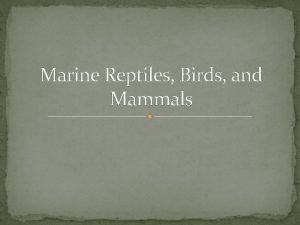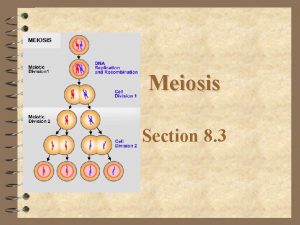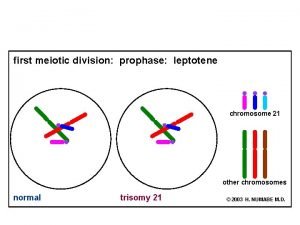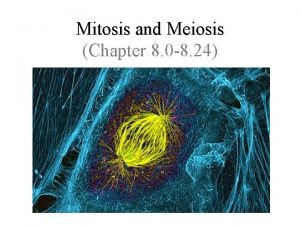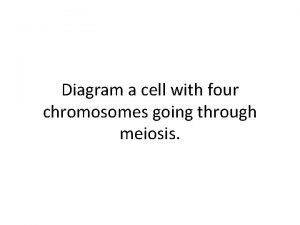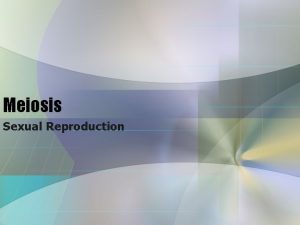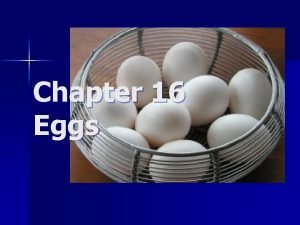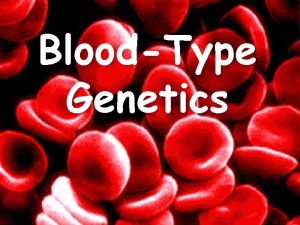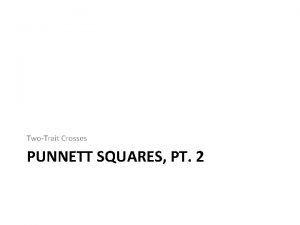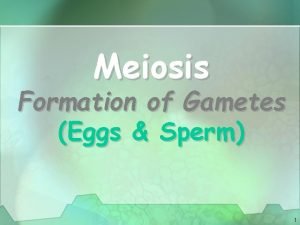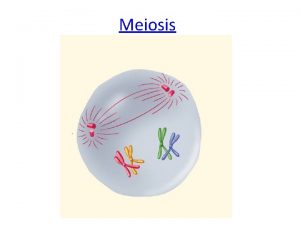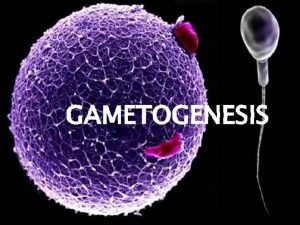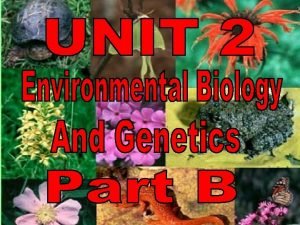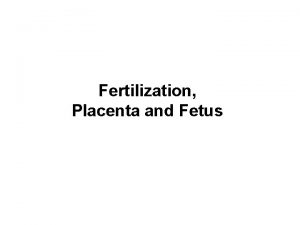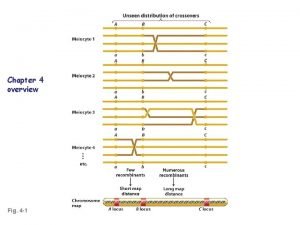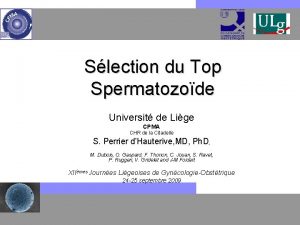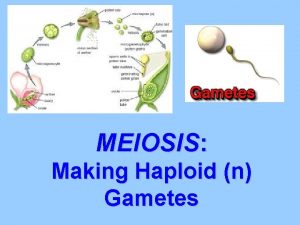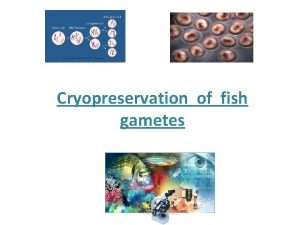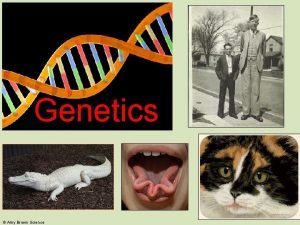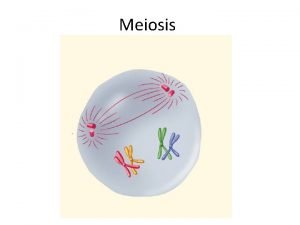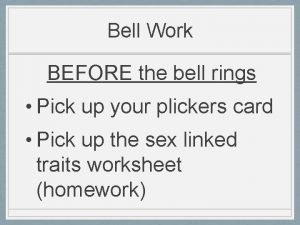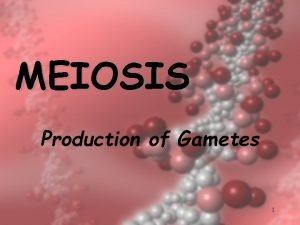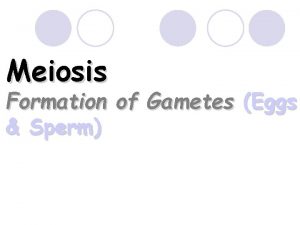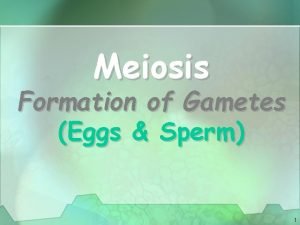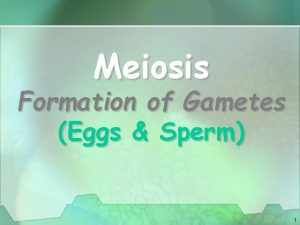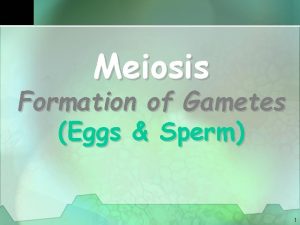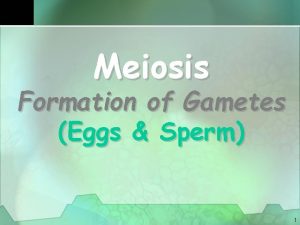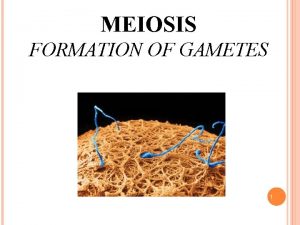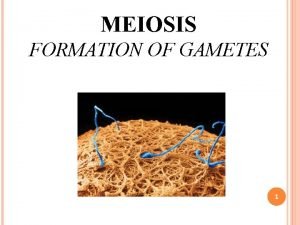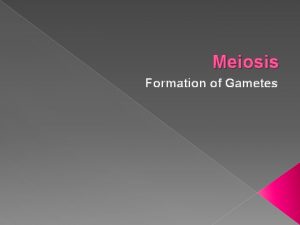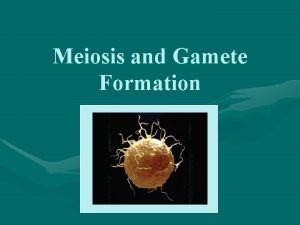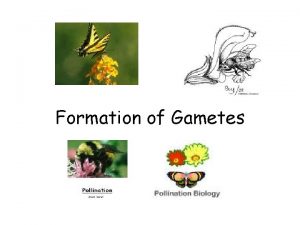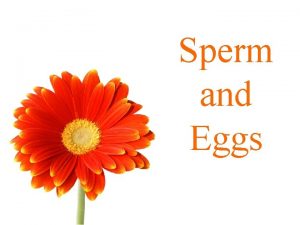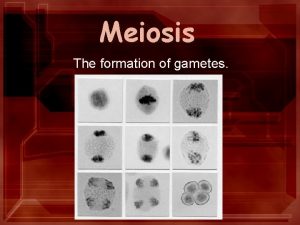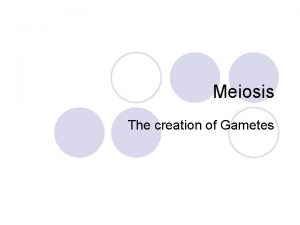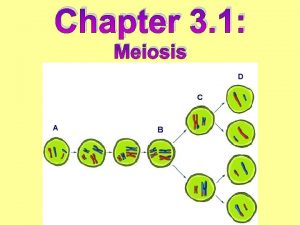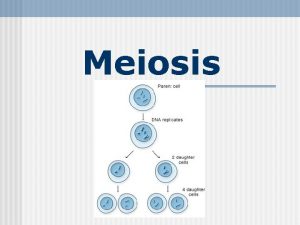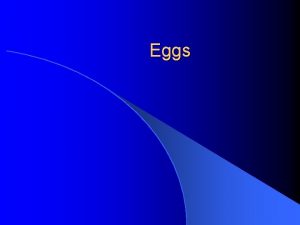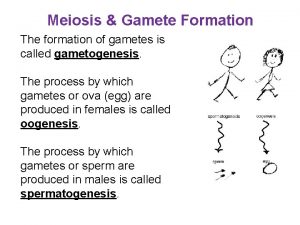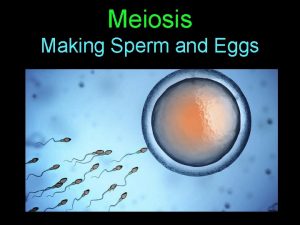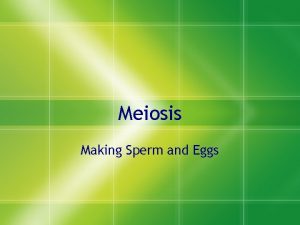Meiosis Formation of Gametes Eggs Sperm 1 Facts


































- Slides: 34

Meiosis Formation of Gametes (Eggs & Sperm) 1

Facts About Meiosis üPreceded by interphase which includes chromosome replication üTwo meiotic divisions --- Meiosis I and Meiosis II üCalled Reduction- division üOriginal cell is diploid (2 n) üFour daughter cells produced that are monoploid (1 n) 2

Facts About Meiosis üDaughter cells contain half the number of chromosomes as the original cell üProduces gametes (eggs & sperm) üOccurs in the testes in males (Spermatogenesis) üOccurs in the ovaries in females (Oogenesis) 3

More Meiosis Facts ü Start with 46 double stranded chromosomes (2 n) üAfter 1 division - 23 double stranded chromosomes (n) üAfter 2 nd division - 23 single stranded chromosomes (n) ü Occurs in our germ cells that produce gametes 4

Why Do we Need Meiosis? üIt is the fundamental basis of sexual reproduction üTwo haploid (1 n) gametes are brought together through fertilization to form a diploid (2 n) zygote 5

Fertilization – “Putting it all together” 2 n = 6 1 n =3 6

Replication of Chromosomes ü Replication is the process of duplicating a chromosome ü Occurs prior to division ü Replicated copies are called sister chromatids ü Held together at centromere Occurs in Interphase 7

A Replicated Chromosome Gene X Homologs (same genes, different alleles) Sister Chromatids (same genes, same alleles) Homologs separate in meiosis I and therefore different alleles separate. 8

Meiosis Forms Haploid Gametes ü Meiosis must reduce the chromosome number by half ü Fertilization then restores the 2 n number from mom from dad child too much! meiosis reduces genetic content The right number! 9

Meiosis: Two Part Cell Division Sister chromatids separate Homologs separate Meiosis II Diploid Haploid 10

Meiosis I: Reduction Division Nucleus Early Late Prophase I (Chromosome Prophase I number doubled) Spindle fibers Nuclear envelope Metaphase Anaphase Telophase I I I (diploid) 11

Prophase I Early prophase üHomologs pair. üCrossing over occurs. Late prophase üChromosomes condense. üSpindle forms. üNuclear envelope fragments. 12

Tetrads Form in Prophase I Homologous chromosomes (each with sister chromatids) Join to form a TETRAD Called Synapsis 13

Crossing-Over ü Homologous chromosomes in a tetrad cross over each other ü Pieces of chromosomes or genes are exchanged ü Produces Genetic recombination in the offspring 14

Crossing-Over Crossing-over multiplies the already huge number of different gamete types produced by independent assortment 15

Metaphase I Homologous pairs of chromosomes align along the equator of the cell 16

Anaphase I Homologs separate and move to opposite poles. Sister chromatids remain attached at their centromeres. 17

Telophase I Nuclear envelopes reassemble. Spindle disappears. Cytokinesis divides cell into two. 18

Meiosis II Gene X Only one homolog of each chromosome is present in the cell Sister chromatids carry identical genetic information. Meiosis II produces gametes with one copy of each chromosome and thus one copy of each gene. 19

Meiosis II: Reducing Chromosome Number Prophase Metaphase II Telophase II Anaphase 4 Genetically II II Different haploid cells 20

Prophase II Nuclear envelope fragments. Spindle forms. 21

Metaphase II Chromosomes align along equator of cell. 22

Anaphase II Equator Pole Sister chromatids separate and move to opposite poles. 23

Telophase II Nuclear envelope assembles. Chromosomes decondense. Spindle disappears. Cytokinesis divides cell into two. 24

Results of Meiosis Gametes (egg & sperm) form Four haploid cells with one copy of each chromosome One allele of each gene Different combinations of alleles for different genes along the chromosome 25

Gametogenesis Oogenesis or Spermatogenesis 26

Spermatogenesis ü Occurs in the testes ü Two divisions produce 4 spermatids ü Spermatids mature into sperm ü Men produce about 250, 000 sperm per day 27

Spermatogenesis in the Testes Spermatid 28

Spermatogenesis 29

Oogenesis üOccurs in the ovaries üTwo divisions produce 3 polar bodies that die and 1 egg üPolar bodies die because of unequal division of cytoplasm üImmature egg called oocyte üStarting at puberty, one oocyte matures into an ovum (egg) every 28 days 30

Oogenesis in the Ovaries 31

Oogenesis First polar body may divide (haploid) a Mitosis Oogonium (diploid) X A X Primary oocyte (diploid) X a a Polar bodies die X Meiosis II (if fertilization A occurs) X A X Secondary oocyte (haploid) Ovum (egg) Mature egg A X Second polar body (haploid) 32

Comparing Mitosis and Meiosis 33

Comparison of Divisions Mitosis Number of divisions Number of daughter cells Genetically identical? 1 Meiosis 2 2 4 Yes No Same as parent Half of parent Where Somatic cells Germ cells When Throughout life At sexual maturity Growth and repair Sexual reproduction Chromosome # Role 34
 Killer whale eating sea lion
Killer whale eating sea lion Meiosis reproduction
Meiosis reproduction Meiotic division
Meiotic division Function of meiosis
Function of meiosis Diagram a cell with four chromosomes going through meiosis
Diagram a cell with four chromosomes going through meiosis Meiosis makes gametes
Meiosis makes gametes Chapter 17 eggs selecting and storing eggs
Chapter 17 eggs selecting and storing eggs What is the difference between mitosis and meiosis 2
What is the difference between mitosis and meiosis 2 11/15
11/15 Chapter 10 section 1 meiosis answer key
Chapter 10 section 1 meiosis answer key Meiosis 1 vs meiosis 2
Meiosis 1 vs meiosis 2 Chapter 10 section 10.2 meiosis worksheet answer key
Chapter 10 section 10.2 meiosis worksheet answer key Meiosis and genetic variation usatestprep
Meiosis and genetic variation usatestprep Telophase
Telophase B+ blood type ethnicity
B+ blood type ethnicity Punnett square with 2 traits
Punnett square with 2 traits Gametes definition
Gametes definition Gamete formation
Gamete formation Define gametogenesis
Define gametogenesis How to foil genotypes
How to foil genotypes Gametes
Gametes Dihybrid cross foil method
Dihybrid cross foil method Haploid
Haploid Gametes
Gametes Gametes
Gametes Rencontre des gamètes
Rencontre des gamètes Gametes
Gametes Foil method gametes
Foil method gametes Urinary system interesting facts
Urinary system interesting facts Cryopreservation of fish gametes
Cryopreservation of fish gametes Gamete vs somatic cell
Gamete vs somatic cell Roan coat cow
Roan coat cow Process of gametes
Process of gametes Foil method gametes
Foil method gametes Facts about meiosis
Facts about meiosis
